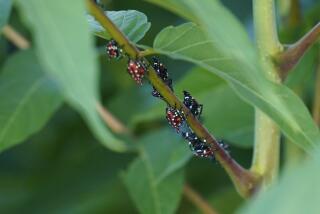Fly Species Making Its Debut in New Habitat
- Share via
The mating of flies that lay maggots on blueberries with flies whose maggots prefer snowberries has created an evolutionary oddity: an emerging fly species whose maggots eat only honeysuckle.
The discovery, published online Thursday in the journal Nature, was made by scientists at Pennsylvania State University working in the lab of entomologist Bruce McPheron.
Postdoctoral researcher Dietmar Schwarz was wandering across campus one day when he noticed that the fruit on some honeysuckle shrubs from Asia was infested with maggots.
The maggots came from eggs laid by a group of parasitic fruit flies, known as Rhagoletis, that infest plants such as apples, blueberries, cherries, snowberries, hawthorns and dogwoods, depending on the species.
McPheron’s group collected hundreds of honeysuckle maggots and analyzed their enzymes and DNA. The maggots, it turned out, were hybrids between snowberry-infesters and blueberry-infesters.
The scientists theorize that the nonnative honeysuckle from Asia provided a new habitat on which the hybrid flies could thrive without competition from their parent species.
In addition, the hybrids keep breeding with each other, instead of with their parent species, because they travel to the honeysuckle to mate, whereas the parents go to the blueberry or snowberry plant.
Schwarz said that although there were plenty of examples of new plant species having formed through hybridization, there were few in the animal kingdom: The hybrids, such as mules, have traditionally been thought to end up as sterile dead ends.
“That attitude is changing,” Schwarz said.
The list of animal hybrid species has recently been growing with finds including a red wolf, certain fish and a water flea.
More to Read
Sign up for Essential California
The most important California stories and recommendations in your inbox every morning.
You may occasionally receive promotional content from the Los Angeles Times.








